A SLOW STEAMBOAT TO CHINATOWN
A slow steamboat to Chinatown.
Bee Hoon Hor Fun. If you say it with an Australian accent, it could refer to a bogan blokes’ night out with V8 Commodores and naughty girls. But if you see it written along with Chinese characters out front of a street restaurant in Penang, it is just another of the almost endless food innovations of this majority Chinese Malaysian city that has fascinated me and my tastebuds for more than 35 years.
I’m not sure what the dish really is, probably some kind of noodle concoction. There are so many food variations that nearly every restaurant or humble street food stall seems to offer something different. That is why Penang is classified as one of the top food cities in East Asia, no small achievement in a region of the world known for interesting eating.
I first visited Penang in 1980 and unexpectedly spent my first night in a brothel. The Tong Lock Hotel was not my first choice, but arriving at nearly midnight I didn’t have many choices. I was taken upstairs to my room by an old Chinese man, who when he tried the key in the door, was repelled by a woman’s voice within who screamed something in a Chinese dialect. He motioned me to wait on a bench outside the door. Eventually a young man tore out of the door wearing a motorcycle helmet and sprinted down the stairs. He had dark skin and a wispy beard and I presumed he was a Malay Muslim. The woman who had been attending to his needs emerged next, fixing her clothing. She apologised to me in her best Chinglish: “sorry no finish.”
I went and flopped exhausted on the still warm sheets wondering if the Muslim guy had kept his helmet on during the proceedings, hoping Allah wouldn’t recognise him for his sin.
My plans to check out of the hotel the next day foundered, I stayed a week and I found myself getting quite friendly with the girls who never tried to engage me in any transaction except a challenge to games on the hotel’s one pinball machine with the loser to pay. I always paid. I guess that was the extent of my Hor Fun.
I was lured to Penang this time for some gastronomic consolation before allowing surgery on that part of the male anatomy that plays up on blokes my age and has a name that is often confused with an adjective that describes a position on the ground adopted by the very submissive. If that is not enough of a clue, the word starts with ‘p’.
There have been six or seven visits to Penang since the first and I have always been transfixed by its old centre called Georgetown with its streets of quirky terraced Chinese shophouses that as the name suggests, were designed for families to live and work in the same structure. There could be any sort of business on the ground floor: shop, warehouse, restaurant or even a small factory, while the family lived in the one or occasionally, two stories above.
In the better streets there were mansions built by successful Chinese or Malay businessmen. In their declining years a lot of these were turned into cheap hotels like the Tong Lock.
Such streetscapes have been almost totally wiped out in the edifice complex driven corporate state that has become Singapore and have largely disappeared in Malaysia’s capital Kuala Lumpur, a city that now resembles a kind of Disney inspired Islamic Tomorrowland, but not rich enough to go to the extremes of Dubai.
Neglect had saved Penang’s centre, but we always feared its charm could not withstand the bombastic developer bravado that underpins modern life, particularly when a lot of the local wealthy Chinese associated success with things big, new and shiny.

Neglected but saved shophouses with the 1960s Komtar highrise behind. All of Georgetown could have been like that.
We were wrong. Enough of the locals realised the city, once called ”The Pearl of the Orient” was still a gem and despite some opposition, succeeded in 2008 in having the heart of the old capital, Georgetown listed as a UNESCO world heritage site. It could also be the outsider factor. Penang locals would not be the first to need the admiration of others to look, appreciate and remind them what they have. From the people we spoke to: local Chinese, Malays and European expatriates, the listing has been a huge success.

Cathay Hotel, it had a brothel attached when we stayed in 1989. Now it is being restored as a mansion for a wealthy local.
The mansions are being restored in to expensive hotels, offices, museums or some even back into mansions. Some shophouses have also become tourist oriented; restaurants, bars, boutique hotels museums and so on, but the charm of the place is that most continue to be what they always were: homes or businesses with accommodation above.
However, there is one new use that appears to be growing quickly and adapting to the foreign admiration- the shophouse homestay or even better, the whole house renovated and rented for the price of an average hotel room.
After years wondering what shophouse living would be like we took the chance and rented a renovated one we found advertised on Airbnb. It was in a row of 10 terraces on one side of a lane so small and obscure that our lifelong Penang resident taxi driver had never before been there.
As a concession to guests from cooler climates, three of its rooms were air-conditioned, including the main room downstairs and the main bedroom. They needed to be because we soon realised the house front was on the sunny side of the street, and in the dry season the city was experiencing higher than expected temperatures for late January, the locals blamng it on El Nino and climate change. Most days peaked out at 36 to 38 degrees, instead of the 32 normally expected at this time and even most of the locals were beginning to wilt.
The house had a well equipped kitchen, but we did not use it- the eating out choices were too tempting- extensive, varied and mostly cheap.
But there was one temptation in the kitchen that I was busting to use. When we first arrived in Penang we stayed four days in a high rise apartment up the coast near the resort beach Batu Ferringhi. There were no shops or restaurants near the apartment. On a visit to the enormous new Tesco supermarket soon after we arrived in Penang, I bought a steamboat. I am not talking about the kind of steamboat that might feature in a slow boat to China, but table top cooking device popular with Chinese and other East Asians. They are a bit like an oriental fondu and sometimes known as a fire pot or hot pot.
I have two of them at home, the traditional type where you put hot coals or charcoal down the centre chimney to heat a stock held in a circular metal ring around it. Each diner chooses the food they want and drops it into the liquid to cook. But the charcoal fired ones are a hassle to get going and to keep the cooking temperature correct. The one at Tesco you put on a small tabletop butane stove, but its best feature was inside it had four segments ensuring each diner’s preferred foods were not mixed with others’. This is important to Jill who doesn’t like shellfish or crustaceans usually featuring in steamboat offerings.
I bought the little gas stove at another nearby shop, but had to resist using the setup until I got home, even though I could not resist getting it from its box now and then to admire. I am sure I could have found something similar Melbourne’s Asian shops, but that’s not the point. Part of the pleasure of travelling are the treasures you bring back which remind you of the trip every time they are used.
Not using it did not stop us having a steamboat. We found lots of great eating places, just walking the streets each night. One nearby did traditional steamboat with the charcoal fire in the centre and a stock of fishhead soup.
When we bought our Tesco steamboat (which was on sale half price for Chinese New Year) we showed it to the elderly Chinese mother of the woman who owned our northern apartment facing a beach curiously named Miami Bay. She was impressed by the device, but when we showed it to a younger guy, he was not, saying it should have the centre chimney and be heated by charcoal. This he asserted was what Chinese preferred. This must however be a Chinese Malaysian thing because four years ago when we visited Hong Kong, the steamboats we sampled there were all powered by tabletop gas stoves.
And after returning to Melbourne and trying it out several times, I can attest the gas version is easier to use, not suddenly running out of heat while you still have half the ingredients to cook.
Speaking of the Miami Bay apartment, I was keen to rent one in a high rise because it contrasted to the shophouse, and also represented what many locals aspire to. Outside the heritage centre of Georgetown the island is sprinkled with so many and of such height the landscape these days looks like a pin cushion. Indeed we were told many apartments had been bought by wealthy mainland Chinese and were left empty. Apparently because of restrictions the Chinese government imposes on moving money from the country, buying a foreign property is seen as a means of warehousing wealth off-shore.
Our apartment had a great view of not only Miami Bay but also north to the resort island of Langkawi. The beach, which we accessed diving across the main northern road, had a small restaurant and a handful of shops, but a very elaborate new toilet complete with men’s and women’s Islamic prayer rooms. When I spoke about this to a Chinese guy, he expressed resentment that on a majority Chinese island, taxpayers’ money was lavished on mosques and prayer facilities, but he claimed the Chinese had to raise money themselves if they wanted to build or repair a temple or clan house. It was a form of apartheid, he said.
The beach was popular with local Muslim families, with the women quite happy to take to the water in their full gear and headscarf. It made a nice change from the Saudi tourists where the guys relax in shorts and T shirts, while their women are fully covered in black with only a slit for their eyes. We saw a number of couples like this and the mysogynistic irony did not seem to have occurred to the men. Women imprisoned in this clothing because a religion believes their immature men can’t control their dicks.
But I noticed a number of these black crow look-alikes, at the end of the trip at the airport, had pulled open the eye slit to expose their faces. I wondered what would happen if they continued like this when they returned home.
In contrast, on our beach there was one young woman who was enjoying herself kicking a football to a little girl. She was dressed in the Malay Muslim clobber, but she obviously took her football seriously and was a good accurate kick. She was also obviously unperturbed that such an action in pubic would put her legs into a position that a repressive regime such as Saudi Arabia would interpret as ”immodest.”
To view gallery click on image and scroll using arrows. To exit hit small x at beginning.
- Chinese temple.
- Giant joss.
- Chinese tourists.
- Tourists.
- Tatooed tourist.
- Small mosque
- Tower of famous Kapitan Keling Mosque.
- St George’s Anglican Church
- Front of our shophouse.
- Shophouse 1
- Shophouse 2
- Armenia Street shophouses.
- Shophouse warehouse.
- Shophouse beauty parlour
- Shophouse factory.
- Shophouse as opera house
- Rundown shophouses.
- Neighbour’s shophouse in our lane.
- Shophouses turned into very expensive hotel.
- Old man in very old shophouse.
- A shophouse mock up in a shopping mall.
- Old mansion
- Old corner of town.
- Fancy Nagore Square.
- Rickshaw as food stall.
- Rickshaw as cat lounge.
- Rickshaw waiting for business.
- Illuminated rickshaw
- Rickshaw 2
- Rickshaw 3
- Danish Indian Restaurant.
- Jill goes clothes shopping.
- The romance of Raris.
- Nonya museum
- Museum interior
- Strait Chinese (Nonya) museum pieces.
- Nonya museum pieces 2
- Motor scooter cafe.
- Famous Hainan chicken and rice restaurant.
- Development at all cost.
- Swimming pool in our Miami Bay apartment building.
- Happy Chinese New Year wishes from a Malay politician.
- Muslim girl and image of loose western woman.
- The main races of malaysia.
- Muslim street vendor.
- Old Government House.
- High tea at old government house.
- Chinese Clan jetty.
- Waterfront temple
- Harbour.
- Jetty art.
- discarded decorations




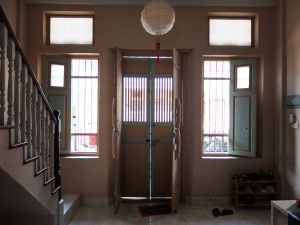





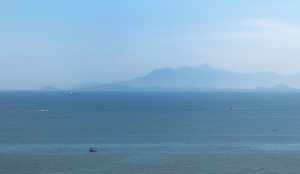












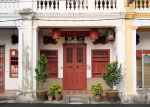
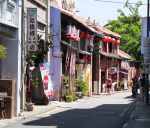
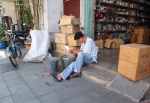





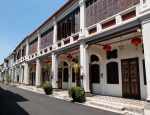
































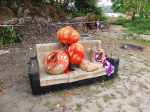
What a nostalgia trip! Reminds me of the late seventies when I visited Penang. Great to see you going back!
Jude
Fabulous photos and writing. Wish I had met you there. Nancy
Pity you couldn’t come, you would have loved it. Geoff.